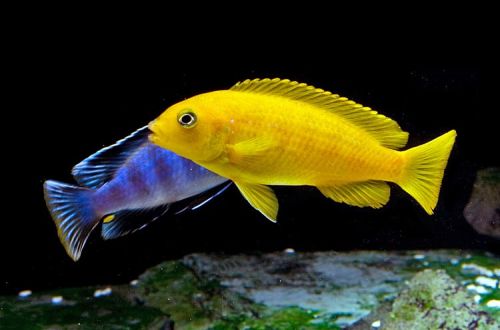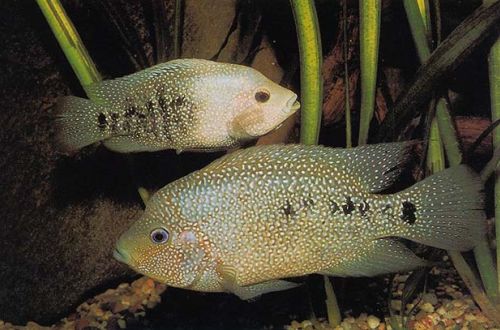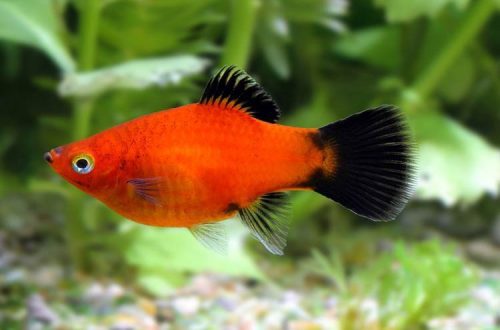
Pseudotropheus saulosi
Pseudotropheus saulosi, scientific name Chindongo saulosi, belongs to the Cichlidae family. Previously, the species was referred to as Pseudotropheus saulosi. Introduce the cichlids of the Mbuna group, which live exclusively in Lake Malawi (Nyasa). Easy to keep and breed. Behavioral features significantly limit the range of possible species for colonization. Beginning aquarists are recommended to keep in a species aquarium.

Contents
Habitat
Endemic to Lake Malawi in Africa, located on the border of the eponymous state of Malawi, as well as Mozambique and Tanzania. It lives at depths of 7–15 meters along the rocky coastline.
Brief information:
- The volume of the aquarium – from 100 liters.
- Temperature – 24-28°C
- Value pH — 7.6–8.8
- Water hardness – medium to high hardness (10-25 dGH)
- Substrate type – sandy
- Lighting – moderate
- Brackish water – no
- Water movement – weak, moderate
- The size of the fish is up to 10 cm.
- Nutrition – any plant-based food
- Temperament – inhospitable
- Keeping in a harem with one male and several females
Description

Adults reach a length of about 10 cm. Males are blue with dark vertical stripes. Females are yellow with barely visible stripes. All fish are born yellow, but as they mature, the alpha males turn blue. It is worth noting that subdominant males look like females, i.e. yellow.
Food
In nature, they feed on algae growing on the surface of pitfalls / rocks. The special structure of the mouth allows them to get such difficult food, but limits the intake of other products. Spirulina-based foods are recommended for home aquariums. You can also simulate the natural growth of algae using spot lighting (more on that below).
Maintenance and care, arrangement of the aquarium
The size of the aquarium depends on the number of fish planned for keeping. For a couple of fish, a tank of 100 liters is enough, a group of a dozen fish will require at least 250 liters. The design is simple and consists of two main elements – a sandy substrate and a heap of rocks and large stones. Their last form grottoes, crevices, caves. This is quite consistent with the natural habitat of Pseudotropheus saulosi. Other decorative elements, including plants, are placed at the discretion of the aquarist.
The natural growth of algae will serve as an excellent additional source of food. A good place for their growth is a bog tree (natural snag), which is under bright lighting. But since the fish themselves do not like a lot of light, you can use a point light source and direct it to a snag.
Successful keeping largely depends on maintaining high water quality with suitable pH and dGH values. For this, in addition to a productive filtration system, it is necessary to carry out regular maintenance procedures for the aquarium. Weekly replacement of part of the water (15-20% of the volume) for fresh and timely removal of organic waste, cleaning glass from plaque, etc.
Behavior and Compatibility
Intraspecific relationships are built on the dominance of the alpha male in a certain territory. A small aquarium should contain only one male in the company of one or more females. In a large tank, multiple males are allowed to mate, provided that each has enough space to form a territory.
Can be combined with other representatives of not too aggressive Mbuna. But you should avoid the introduction of species that have a similar color – yellow and blue.
Breeding / breeding
With the onset of the mating season, the male builds a kind of nest – a place for future spawning. Usually it is an ordinary depression or hole in the sand. The male then proceeds to courtship. When the female is ready, she lays 15–20 eggs and, after fertilization, immediately takes them into her mouth. Further, the incubation period will take place in the mouth of the female. A similar feature of bearing offspring has developed evolutionarily and is characteristic of most cichlids of Lake Malawi.
Fish diseases
The main cause of most diseases in Malawian cichlids is inadequate housing conditions and poor quality food, which often leads to such a disease as Malawi bloat. If the first symptoms are detected, you should check the water parameters and the presence of high concentrations of hazardous substances (ammonia, nitrites, nitrates, etc.), if necessary, bring all indicators back to normal and only then proceed with treatment. Read more about symptoms and treatments in the Aquarium Fish Diseases section.





